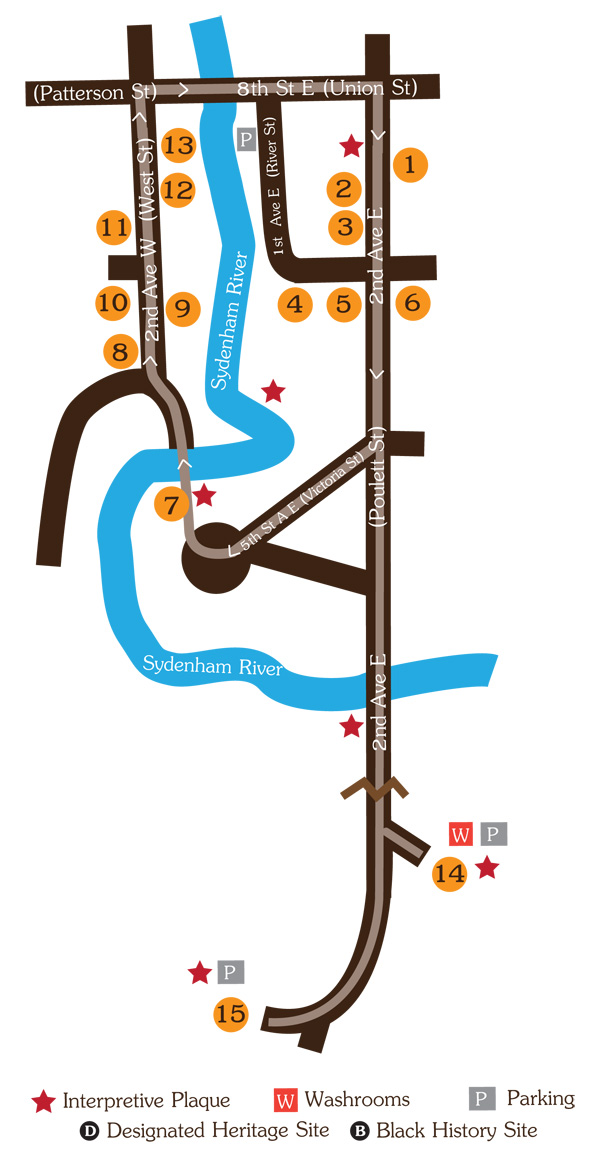

Built in 1912, this theatre saw minstrel shows, Vaudeville and silent movies, with the first talking picture show in 1930. In 1961, the Savoy was sold to Odeon Theatres. In the mid-1980s, the building was completely renovated to accommodate apartments above and storefronts at street level.
Dr. Alan Cameron, a graduate of the University of Glasgow, came to Owen Sound in 1854. He played a major role in the founding of the General & Marine Hospital, was Medical Officer of Health, and Chief Surgeon for the Canadian Pacific Railway. The house was built around 1870.
Like its neighbour at 712, the Dental Clinic is an Italianate structure with a low pitched roof, decorative eves, and the highly ornamental window hoods so often found in this style.
This house was built in 1848 for George and Jane Maughan Snider. They housed the Buchan family for two years while Buchan Manor (see #5) was built. Buchan's daughter, Mary, married Jane's younger brother, Grey County Sheriff Joseph Maughan. Of log construction, later veneered with brick, huge, unpeeled logs support the house.
This Georgian style house was built in 1855 by Walter E. Buchan of Glasgow. The golden limestone walls are 27 inches thick. The ceilings are 13 feet high. Legend has it that an itinerant artist from the United States painted the Union Jack on the ceiling of the dining room, so it could be said the family always dined under the flag of the British Empire.
This Victorian Gothic Revival style house was built around 1875 by boot and shoe store owner James Frizell. It was named after Poulett Street, in turn named after Governor General Lord Sydenham (Charles Poulett Thomson), who presided over the first parliament of Canada. It was later occupied by the McLauchlans, owners of the McLauchlan Biscuit & Confectionery Company (see #10).
In the 1840s, Surveyor Charles Rankin set aside 35 acres for a mill reserve on the Sydenham River. The first dam and a grist mill were built soon after by John Frost. Rainbow trout use the fish ladder in the spring, salmon in the fall, to by-pass the dam on their way up river to spawn. It was the first fish ladder to be built in Ontario.
Note: During winter, the Mill Dam may not be kept snow free.
The Sydenham River rises in marl-bottomed Williams Lake, a kettle lake in the former Holland Township, now part of Chatsworth. It tumbles over the Niagara Escarpment at Inglis Falls. The river is named for Lord Sydenham, Governor-General of Upper Canada in 1841.
Milliner and "fancy goods" merchant Buell Wilcox built this vernacular Ontario Gothic house in 1870. H.H. Bowman purchased the house in the early 1900s and constructed the addition. Bowman was the campaign manager for General Andrew McNaughton in the by-election of 1945 (see #13). An entrepreneur with many interests, Bowman had the first Ford automobile franchise in the City (see Downtown Tour, #19).
Thomas Dates built this house in 1909. A chemical engineer with the Sun Cement Company, Dates built it to demonstrate what could be done with cement blocks.
James McLauchlan emigrated from Scotland in 1854. His biscuit and confectionery company, J.H. McLauchlan & Sons, based in Williamsford in 1869, then Owen Sound (in the 900 block of 3rd Ave East) in 1876, became one of Grey County's largest manufacturers and was sold to National Grocers in the 1940s. His son, William, built this stately English Tudor Revival residence in 1910; the family lived here until 1978.
Thomas Scott came to Owen Sound in 1850 and was a Mason, town councillor, harbour master, mayor and Conservative MPP. At one time he owned all the land from 7th Street to the mill dam. Scott's stone cottage was later enlarged by druggist Arthur Wood Manley (see Downtown Tour, #15).
This lot is believed to have been the site of the first Black church in Owen Sound. Pettigrew built this "Ontario Cottage" circa 1855. A stone cellar accommodated the kitchen and staff quarters. Grocery merchant Donald P. Urquhart bought it in 1880, and it remained in his family until 1974.
Built in 1910, this residence housed two of Owen Sound's mayors: William Webster (1918), and Garfield Case (1945). In a 1945 by-election Liberal Prime Minister Mackenzie King chose North Grey as a riding for General Andrew McNaughton, Minister of National Defence. The conscription issue dominated the election. In a surprise outcome, Case, the Progressive Conservative candidate, defeated McNaughton (see #8).
(See West Side Tour #5, #9) In 1912 Owen Sound acquired the Park and continued its development. The Inn was built in 1915 using local stone. Destroyed by fire in 1985, the Inn was rebuilt, not as a copy of the original but in keeping with its historical character. The Park has been the location of the annual Emancipation Festival Picnic since 1862. Through the symbolism of quilt patterns and interpretive plaques, the Black History Cairn is a memorial to those forced into slavery and their escape to freedom via the Underground Railroad.
Opened to the public in 1854, Greenwood Cemetery contains one of the oldest houses in Owen Sound, now used as an office, built in the late 1840s. A small red brick Gothic Revival Chapel and the 1927 Mausoleum are also of interest. The latter, covered in Indiana limestone and finished with Italian marble inside, has several beautiful Tiffany-style stained glass windows. A Cemetery Walking Tour is available.